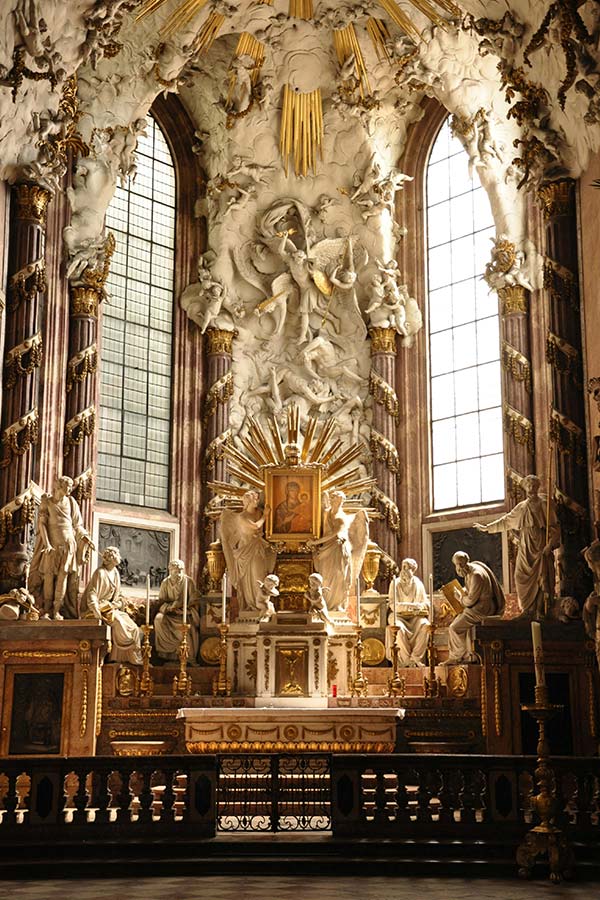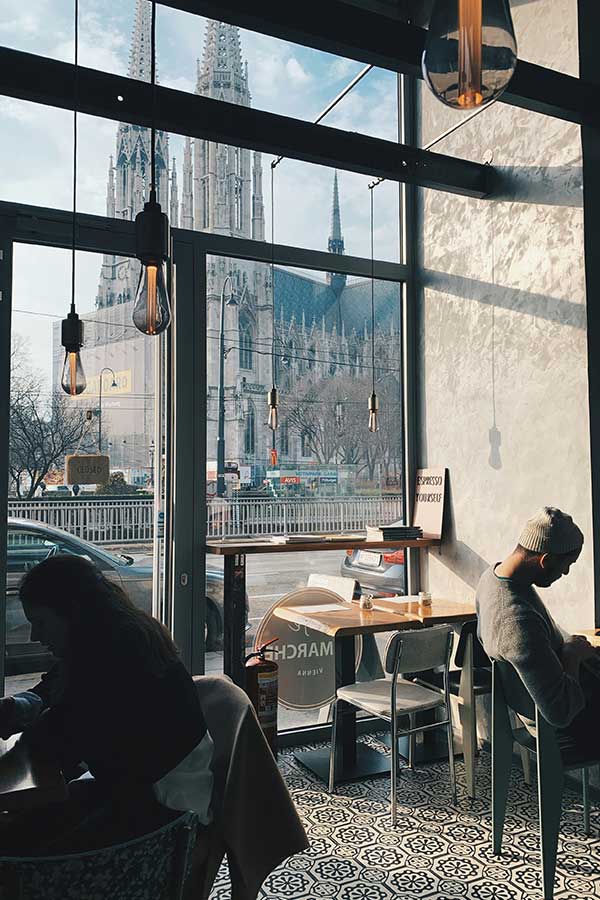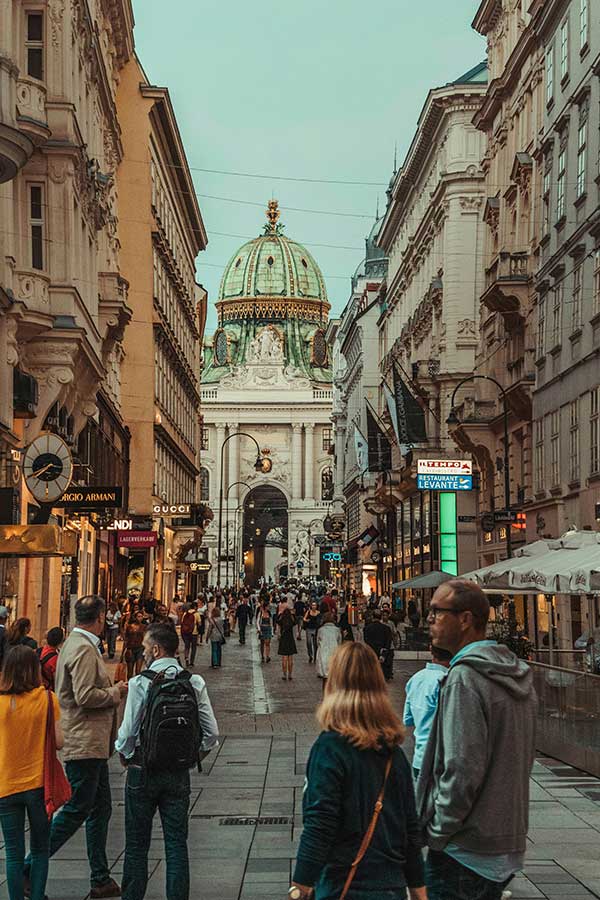Vienna, the city of waltzes and coffee houses, is known for its imperial atmosphere. And we have ways for you to enjoy it, regardless of your budget. Here’s your Vienna travel guide with an emphasis on not burning a hole in your pocket.
Guide Index
Travel Costs: Detailed Breakdown
Vienna charms travelers with its rich history, awesome culture, and affordability. Here’s a breakdown of the average daily budget you can expect:
Suggested Budget per person: Visiting Vienna
- Low: €55-€75
- Middle: €75-€100
- High: €100+
Detailed Costs
Accommodation:
- Low: Hostels or budget guesthouses: €20-€35 per night
- Middle: Mid-range hotels or B&Bs: €40-€70 per night
- High: Luxury hotels or upscale apartments: €100+ per night
Read: Best Hostels in Vienna.
Public Transportation:
- Metro ticket cost: €2.40
- Daily pass: €8
- 3-Day tourist pass: €17.10
Entrance Fees:
- Low – Mostly Free Activities: Schönbrunn Palace Gardens, Danube Canal, St. Stephen’s Cathedral
- Middle: Schonbrunn Palace (Int. Tour): €17.50, Kunsthistorisches Museum: €16
- High: Spanish Riding School Performance: €42-€240, Vienna Hofburg (Imperial Apartments): €17.50
Restaurants:
- Low: Döner Kebab: €4-€6, Würstelstand (Viennese sausages): €2-€4
- Middle: Mid-range restaurants: €10-€15 per main course
- High: Fine dining restaurants: €30+ per main course
Popular Food Staple: Viennese Schnitzel (breaded veal cutlet)
- Low: €8-€12
- Middle: €12-€18
- High: €18+
Coffee:
- Low: Takeaway: €1.50-€2.00
- Middle: Cafe: €2.50-€3.50
- High: Specialty coffees: €4+
Beer & Wine:
- Low: Local bar / pub: €3-€4 per beer, €2-€3 per glass of wine
- Middle: Mid-range restaurant / trendy bar: €4-€5 per beer, €4-€6 per glass of wine
- High: Craft beer / special vintage wine: €5+ per beer, €7+ per glass of wine
*Note: These are general estimates and prices may vary depending on the specific location and establishment.
Exploring Vienna: Things to See & Do
Vienna is a city that seamlessly blends historical grandeur with modern vibrancy. Get ready to explore popular landmarks, delve into fascinating museums, and discover hidden gems that will leave you enchanted. Here’s how to make the most of your time in the Austrian capital:
Must Do: Vienna Guide
- Marvel at the Schönbrunn Palace: The grandeur of the Habsburg dynasty’s former summer residence, boasting stunning gardens, opulent rooms, and a gloriously intricate Gloriette lookout point.
- Explore the Imperial Palace (Hofburg): Wander through the sprawling complex housing various museums, including the Sisi Museum dedicated to the beloved Empress Elisabeth, and marvel at the Spanish Riding School’s world-famous Lipizzaner horses.
- Stroll down the Ringstrasse: Vienna’s Ring Road is lined with magnificent buildings like the Vienna State Opera House, Parliament, and the Burgtheater, offering a glimpse into the city’s architectural wonders.
- Unwind in the Vienna Woods: Escape the city bustle and explore the vast Vienna Woods, offering scenic hiking trails, charming villages, and the historic Mayerling hunting lodge.
- Witness artistic masterpieces at the Kunsthistorisches Museum: Housing an impressive collection of artworks by renowned painters like Titian, Rubens, and Bruegel, this museum is a feast for art lovers.
- Delve into Vienna’s musical heritage: Attend a concert at the world-renowned Vienna State Opera House, visit the house where Mozart once lived, or catch a performance by the Vienna Philharmonic Orchestra.
- Ride the Giant Ferris Wheel: Take a ride on the Riesenrad (Giant Ferris Wheel) in Prater amusement park for breathtaking panoramic views of the city skyline.
- Explore the Museumsquartier: This cultural hub houses several museums, including the Leopold Museum (focusing on modern Austrian art) and the MUMOK (Museum of Modern Art), offering a diverse artistic experience.
- Browse the Naschmarkt: Stroll around the lively atmosphere of Naschmarkt, a sprawling outdoor market offering fresh produce, local delicacies, and international food stalls.
- Discover hidden gems: Venture beyond the main tourist attractions and explore Vienna’s lesser-known gems like the Belvedere Palace with its stunning gardens, the quirky Hundertwasserhaus building, or the Sigmund Freud Museum dedicated to the father of psychoanalysis.
- Imperial Stables (Stallburg): Step back in time at the Stallburg, a historic building that once housed the imperial horses of the Habsburg dynasty. Today, it’s part of the MuseumsQuartier, offering glimpses into the grandeur of the imperial court.
Free things to do in Vienna
- Unwind at the Donau-Auen National Park: Escape the city center and explore the natural beauty of the Donau-Auen National Park, offering hiking and biking trails, a network of canals, and diverse wildlife.
- Witness the Changing of the Guard Ceremony: Witness the Changing of the Guard Ceremony at the Hofburg Palace (every Wednesday, Friday, and Sunday).
- Hunt for hidden street art: Explore the creative side of Vienna by discovering captivating and thought-provoking street art scattered throughout various neighborhoods, especially in the 7th district (Neubau).
- Attend a free organ concert at St. Stephen’s Cathedral: Witness the grandeur of St. Stephen’s Cathedral and enjoy a free organ concert on select Saturdays. Check the cathedral’s website for the schedule.
- Visit the Wien Museum MUSA: Delve into Vienna’s musical heritage at the Wien Museum MUSA, showcasing fascinating exhibits on composers, instruments, and the city’s musical history. Free entry on the first Sunday of every month.
- Join a “Vienna Greeter” tour: Connect with a local volunteer through the “Vienna Greeter” program and get personalized recommendations and insights into Vienna’s hidden gems and local life.
- Explore Vienna’s hidden courtyards: Discover a hidden network of charming inner courtyards (Durchhäuser) scattered throughout the city center, offering a glimpse into Vienna’s historical architecture and hidden oases.
Museums
- Kunsthistorisches Museum: Housing an impressive collection of European art from the Renaissance to the 18th century.
- Belvedere Palace: Home to two museums showcasing Austrian art from the Middle Ages to the 20th century, and offering stunning palace gardens
- Albertina: Renowned for its extensive collection of graphic art, including works by Dürer, Rembrandt, and Picasso.
- Naturhistorisches Museum Vienna: Explore the wonders of the natural world with exhibits on dinosaurs, animals, and minerals.
- Vienna Museum: Delve into the history and culture of Vienna from its Roman roots to the present day. Free entry on the first Sunday of every
Where to Stay: Accommodation Guide
While Vienna is generally an affordable city compared to other European capitals, the most central and touristy areas will naturally be more expensive. Here are some great, budget-friendly neighborhoods to consider for your stay:
Most Popular Area
Innere Stadt (City Center): This is the heart of Vienna, home to iconic landmarks like St. Stephen’s Cathedral and Hofburg Palace. It’s a great place to stay if you want to be in the middle of the action but be prepared for higher accommodation prices.
Affordable Neighborhoods: Vienna Travel Guide
- Leopoldstadt: Located just north of the city center, Leopoldstadt is a trendy and up-and-coming neighborhood with a young, international vibe. It’s home to the famous Prater amusement park and offers a variety of restaurants, cafes, and bars.
- Neubau: This lively district is known for its creative atmosphere and artistic scene. It’s home to the Museum of Modern Art (MUMOK) and numerous galleries, bars, and vintage shops. While slightly pricier than Leopoldstadt, it’s still a good option for budget-minded travelers who want to be close to the action.
- Mariahilf: A charming district known for its traditional cafes, shops, and the famous Naschmarkt, a large outdoor market offering fresh produce, local specialties, and international food stalls. It offers a good balance of affordability and central location, with easy access to public transportation.
- Wieden: Located southwest of the city center, Wieden is a historic district with a mix of grand boulevards, quiet side streets, and hidden gems. It’s home to the Belvedere Palace, a beautiful Baroque complex, and offers a more relaxed and local atmosphere compared to the city center.
Reminder: We have a guide on the Best Hostels in Vienna.
Eating and Drinking
Forget fancy schnitzels and overpriced Apfelstrudel! Vienna offers a smorgasbord of delicious and affordable eats, waiting to conquer your taste buds without plundering your wallet. Here’s your survival guide to navigating Vienna’s culinary scene like a budget-savvy explorer:
Water: Vienna’s tap water is a crystal-clear gift from the gods, so ditch the bottled stuff and refill your water bottle guilt-free. Pro tip: Look for public drinking fountains (“Trinkwasser”) scattered around the city, especially in parks and squares.
Dine Like a Local: Steer clear of tourist traps and venture into the charming neighborhoods. Local eateries, called “Beisln” (pronounced “BOY-zln”), offer hearty, traditional fare at wallet-friendly prices. Look for daily specials (“Mittagstisch”) typically served from 11:30 am to 2 pm, offering a complete meal at a discounted price. Be prepared to practice your German as menus might not be translated, but don’t be afraid to ask for recommendations – locals are often happy to help!
Affordable Eats
Markets:
- Naschmarkt: Vienna’s biggest market, a paradise for fresh produce, international delicacies, and local specialties. Grab a steaming bowl of goulash from one of the many stalls, or sample local cheeses and cured meats.
- Brunnenmarkt: A treasure trove of local produce, artisan cheeses, and mouthwatering street food. On Thursdays, the market transforms into a “Törggelen” market, offering seasonal treats like roasted chestnuts and new wine.
- Karmelitermarkt: A smaller market with a charming atmosphere, perfect for grabbing a quick and delicious bite. Sample freshly baked bread from the local bakery, or indulge in a sweet treat like a “Buchteln” (yeast bun filled with jam).
Food:
- Wurstelstands: These sausage stands are a Viennese institution, offering a variety of hot dogs and sausages at pocket-friendly prices. Don’t just stick to the classics! Try the “Bosna,” a white sausage served in a bun with onions and mustard, or the “Currywurst,” a sausage topped with curry ketchup and curry powder.
- “Bäckereien” (Bakeries): Don’t just stop at pastries! Bakeries often offer savory treats like “Brötchen” (rolls) filled with cheese, ham, or vegetables, perfect for a quick and satisfying snack. Look for the “Gebäck des Tages” (pastry of the day) for a discounted option. Pro tip: Many bakeries offer standing room only, which is typically cheaper than sitting down.
- “Leberkas”: A local favorite, this baked meatloaf is typically served in a bun with mustard or horseradish. Look for “Leberkas Pepi,” a popular local chain known for its delicious and affordable Leberkas. They even offer vegetarian options!
Grocery Gems:
- Hofer: A popular discount supermarket chain offering a wide selection of quality products at low prices. Stock up on essentials like bread, pasta, and vegetables. They also have a decent selection of pre-made sandwiches and salads for lunch on the go.
- Lidl: Another budget-friendly supermarket chain with a good variety of fresh produce and household items. Look for their weekly offers and discount sections for even better deals.
- Billa: A convenient grocery store chain found throughout the city, offering competitive prices and a decent selection of essentials. They often have pre-packaged fruits and vegetables, perfect for a quick and healthy snack.
*Bonus Tip: Vienna’s cafes often offer “kleine Brauner” (small coffees) and pastries at reasonable prices, making them a great option for a budget-friendly breakfast or afternoon pick-me-up. Just remember, you might need to stand at the bar for a cheaper option compared to sitting at a table. Additionally, many restaurants offer lunch menus (“Mittagsmenüs”) at a discounted price, so keep an eye out for those during your exploration.
**Extra Pro Tip: Take advantage of Vienna’s “Heuriger” culture. These traditional taverns serve local wine and small, simple dishes at affordable prices. They are often located on the outskirts of the city and offer a unique glimpse into Viennese culture. Just be aware that they might not be open every day, so plan your visit accordingly.
Transportation Tips for Vienna
Vienna’s public transportation system is like a Viennese waltz, elegant, efficient, and surprisingly affordable. Forget the high notes of expensive taxis and embrace the sweet melody of budget-friendly options. This guide will be your conductor, leading you through the different instruments of Vienna’s transportation network and offering tips to keep your trip financially harmonious.
Understanding Vienna’s Public Transportation
- Vienna Metro (U-Bahn): Dive into the city’s underground network, easily identifiable by the prominent blue “U” symbol. Five lines connect major landmarks like Schönbrunn Palace (U4 line), the Vienna State Opera (U1 line), and the Prater amusement park (U1 line). While fast and reliable, the U-Bahn might not reach every corner of the city.
- Trams (Straßenbahn): Hop on a charming yellow tram for a more leisurely journey. These vintage beauties meander through the city, offering a unique perspective and access to areas not served by the U-Bahn. Popular tram lines include the D line, which traverses the Ringstraße, Vienna’s famous boulevard, and the 1 line, which takes you to the Schönbrunn Palace gardens.
- Buses: A comprehensive bus network complements the U-Bahn and trams, reaching every corner of the city. Look for the white buses with red lettering. They’re perfect for venturing off the beaten path, exploring neighborhoods like Neubau (7A bus), or visiting the Vienna Woods (44A bus).
Tips for Saving on Transportation in Vienna
- Vienna Card: Grab your conductor’s baton, the Vienna Card, for unlimited travel on all public transport for 24, 48, or 72 hours. This card also grants free or discounted entry to over 60 top attractions, making it a budget-friendly maestro. Prices start at €19 (24 hours) and increase based on the duration of validity.
- Weekly Tickets: If you’re staying longer, consider a weekly ticket, offering unlimited travel for seven consecutive days. This option is more economical than buying daily passes, especially if you plan to use public transport frequently. Prices start at €39.10 for adults.
- Single Tickets: For occasional rides, single tickets are available, valid for 1.5 hours, and allow unlimited transfers within that timeframe. Prices start at €2.30 for adults and can be purchased at ticket vending machines at metro stations, tram stops, and some bus stops.
Cheapest Way to Get To and From the Airport in Vienna
Vienna boasts only one airport, Vienna International Airport (VIE), conveniently located just outside the city center. Here’s how to get there without breaking the bank:
- The S-Bahn: The S7 train is the champion of affordability, whisking you between the airport and Vienna City Center (Wien Mitte station) in just 23 minutes for a mere €4.40 (one-way ticket). Trains run every 30 minutes from 4:30 am to 0:30 am.
- CAT (City Airport Train): For a faster (16 minutes) but slightly pricier option, consider the CAT. Tickets start at €12 and offer a more comfortable journey with spacious seats, luggage racks, and Wi-Fi. Trains run every 30 minutes from 5:12 am to 11:12 pm.
- Bus: Several buses connect the airport to various points in Vienna, with prices starting around €8 (one-way ticket). While slower than the trains, they might suit your itinerary or accommodation location. Popular options include the Vienna Airport Lines (VAL) buses and the City Airport Train (CAT) buses.
Remember:
- Validate your ticket before boarding any form of public transportation to avoid a fine.
Purchase tickets at ticket vending machines or mobile apps like “Wiener Linien” for added convenience. - Vienna offers a variety of discounts on public transportation for students, seniors, and families. Check the Wiener Linien website (Wiener Linien = Vienna Lines) for details.
Best Time to Visit Vienna
- High Season (June-August):
Pros: Pleasant weather with comfortable daytime temperatures averaging around 24°C (75°F), ideal for exploring outdoors. Numerous festivals and events take place, including the Vienna Summer Festival and Danube Island Festival, offering a great atmosphere.
Cons: Crowded attractions, especially popular landmarks like Schönbrunn Palace and St. Stephen’s Cathedral. Expect higher accommodation prices compared to other times of the year.
- Shoulder Season (April-May & September-October):
Pros: Milder weather with comfortable temperatures ranging from 15°C to 20°C (59°F to 68°F), perfect for sightseeing and outdoor activities. Fewer crowds compared to peak season, making exploration more enjoyable. Reasonable accommodation prices compared to the high season.
Cons: Occasional rain showers are possible, so pack an umbrella or raincoat.
- Low Season (November-March):
Pros: Lowest accommodation prices throughout the year. Fewer crowds, allowing for a more relaxed sightseeing experience. Festive Christmas markets in December offer a magical atmosphere with charming decorations, traditional food, and mulled wine.
Cons: Colder weather with average highs ranging from 2°C to 8°C (35°F to 46°F), and potential for snowfall, requiring warm clothing and waterproof shoes. Shorter daylight hours, limiting sightseeing opportunities compared to summer months. Some attractions, especially outdoor spaces and gardens, may have reduced opening hours.
National Holidays & Peak Festivals
- Easter week: Expect crowded attractions and higher prices for flights and accommodation.
- Christmas markets (December): Prague’s Christmas markets are a major tourist draw, impacting availability and prices significantly. Book well in advance if you plan to visit during this time.
- Czech Republic national holidays: Be aware of national holidays such as May 1st (Labor Day) and July 5th (Cyril and Methodius Day), as these can also lead to increased prices and crowds.
- Prague International Film Festival (usually held in February): Attracts cinephiles, potentially impacting hotel and flight availability and prices.
- Prague Marathon (usually held in May): Popular marathon attracting runners and supporters, contributing to increased demand for accommodation and potentially higher prices.
- Prague Fringe Festival (usually held in June): Contemporary performance art festival attracting crowds and potentially influencing hotel and flight prices.
- International Jazz Festival Prague (usually held in July): Draws music lovers, potentially affecting hotel and flight availability and prices.
- Oldtimers Rally (usually held in August): Vintage car rally attracting enthusiasts and potentially impacting hotel room availability and raising prices.
- Prague Autumn International Music Festival (usually held in September): Classical music festival spanning several weeks, attracting music aficionados and potentially influencing hotel and flight prices.
Backpacker Essentials & Safety Tips
Vienna, the “City of Dreams,” welcomes budget-savvy explorers with its imperial charm, culture, and delicious cuisine. But before you embark on your Viennese adventure, here’s a city-specific guide to essential items, safety tips, and things to avoid to ensure a smooth and unforgettable experience:
Essential Items:
- Comfortable Walking Shoes: Vienna is a walkable city, and you’ll likely spend a lot of time exploring on foot. Pack comfortable shoes with good traction to navigate cobbled streets and hidden alleyways without any blisters.
- Lightweight Rain Jacket: While Vienna experiences sunshine most days, unexpected showers are not uncommon. Pack a lightweight, foldable rain jacket to keep you dry.
- Travel Adapter: Austria uses a two-pin continental plug. Pack a travel adapter to ensure your electronic devices stay charged.
- Reusable Water Bottle: Save money and stay hydrated and eco-friendly by carrying a reusable water bottle. Vienna boasts numerous public drinking fountains called “Trinkwasser” where you can refill throughout the day.
Safety Tips
- Beware of Pickpockets: As in any major city, pickpockets can be present in crowded areas like tourist attractions (especially around Stephansplatz and Schönbrunn Palace) and public transport. Keep your valuables secure in a money belt or a secure front pocket of your backpack or clothing, and avoid carrying large sums of cash.
- Be Wary of “Friendly Strangers” Offering Help: While most Viennese are genuinely friendly and helpful, be cautious of individuals offering unsolicited assistance, especially near tourist attractions. They might be trying to distract you while an accomplice picks your pockets. If someone approaches you offering “help” with your luggage or directions, politely decline and move on.
Common Scams
- Fake Taxi Drivers: Avoid unlicensed taxi drivers who might overcharge you. Always use official taxis from designated taxi ranks (especially at airports and train stations) or order them through reputable ride-hailing apps like Uber.
- Overpriced Souvenirs: Be cautious of overly enthusiastic vendors selling overpriced souvenirs, especially around tourist hotspots like Stephansplatz and Naschmarkt. Research fair prices beforehand and don’t be afraid to bargain politely.
Things Not to Do
- Eating or Drinking on Monumental Steps or Fountains: Vienna takes pride in its pristine public spaces. Public consumption of food and beverages is prohibited on monumental steps, fountains, and historical landmarks like the Hofburg Palace, Karlskirche, and Schönbrunn Palace.
- Jumper Cables: Vienna’s efficient public transportation system, including the U-Bahn (metro), trams, and buses, might spoil you. Avoid renting a car unless you plan on venturing outside the city limits to explore the Austrian countryside or neighboring countries. Parking is expensive and navigating the city center with a car can be challenging.
- Public Displays of Intoxication: While Vienna has a relaxed attitude towards alcohol consumption, public intoxication is frowned upon. Celebrate responsibly and avoid excessive drinking in public areas.
- Littering: Vienna is a clean city, and littering is strictly enforced. Dispose of your waste responsibly in designated bins to avoid fines. Additionally, avoid using public restrooms as toilets and dispose of feminine hygiene products appropriately.
Resources Money Saving Tips
Conquering Vienna doesn’t have to break the bank! Here are some resources and tips tailored specifically to help you stretch your travel budget further in the beautiful Austrian capital:
Budget-Friendly Passes:
- Vienna City Card: This all-in-one card is your best friend if you plan on using public transportation frequently and hitting the main attractions. It grants you: Unlimited travel on public transportation (metro, trams, and buses) for the chosen duration (24, 48, 72, or 120 hours). Free entry to over 60 museums and attractions, including must-sees like Schönbrunn Palace, the Hofburg Palace, and the Vienna Giant Ferris Wheel. Discounts on others, including restaurants, shops, and tours.
- Vienna Pass: Similar to the Vienna City Card, this pass offers free entry to over 60 attractions and discounts on others, but without unlimited public transportation. This is a good option if you plan on visiting many attractions but are comfortable walking or using single tickets for public transport.
- Weekly Tickets: If you’re staying in Vienna for a longer duration (a week or more) and plan on using public transport frequently, consider purchasing a weekly ticket. This offers unlimited travel within Vienna’s public transportation network for seven consecutive days, making it a cost-effective option for exploring different neighborhoods.
Budget-Friendly Tips in Vienna:
Student Discounts: Many museums and attractions in Vienna offer discounted entry for students. If you’re a student, be sure to carry your student ID to take advantage of these savings. Some popular attractions offering student discounts include:
- Kunsthistorisches Museum (Art History Museum)
- Albertina Museum
- Vienna Zoo (Tiergarten Schönbrunn)
- Schönbrunn Palace
- Hofburg Palace
Free Museum Days: Several museums in Vienna offer free entry on specific days or evenings. By planning your itinerary around free museum days and taking advantage of these budget-friendly options, you can experience the best of Vienna without breaking the bank!







